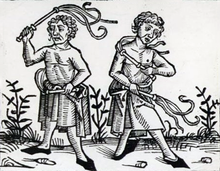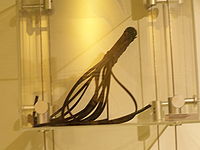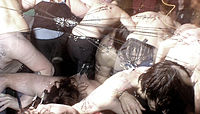- Mortification of the flesh
-
For the theological doctrine, see Mortification (theology). For the theological doctrine from a Roman Catholic perspective, see Mortification in Roman Catholic teaching. For the Christian metal band, see Mortification (band).
Mortification of the flesh literally means "putting the flesh to death". The term is primarily used in religious and spiritual contexts. The institutional and traditional terminology of this practice in Catholicism is corporal mortification.
Contents
Etymology and Christian roots
The term "mortification of the flesh" comes from Saint Paul in this quote: "For if you live according to the flesh you will die, but if by the Spirit you put to death the deeds of the body you will live.".[1] The same idea is seen in the following verses: "Put to death what is earthly in you: fornication, impurity, passion, evil desire, and covetousness, which is idolatry";[2] "And those who belong to Christ Jesus have crucified the flesh with its passions and desires".[3]
According to Christian exegesis, "deeds of the body" and "what is earthly", refer to the "wounded nature" of man or his concupiscence (evil inclinations due to forming part of the Fall of Man); humanity suffers the consequences of the original sin.
Thus, Jesus expected believers to repent from slavery to their flesh's desires: "Woe to you, Korazin! Woe to you, Bethsaida! For if the miracles that were performed in you had been performed in Tyre and Sidon, they would have repented long ago, sitting in sackcloth and ashes".[4]
Forms
In its simplest form, mortification of the flesh can mean merely denying oneself certain pleasures, such as abstaining from alcoholic beverages, meats, dairy products, etc. It can also be practiced by choosing a simple or even impoverished lifestyle; this is often one reason many monks of various religions take vows of poverty.
In some of its more severe forms, it can mean causing self-inflicted pain and physical harm, such as beating, whipping, piercing, or cutting.
Purposes
In the same way that people who change their appearance through painful means will sacrifice and deny themselves in order to attain some physical or material goals, some people voluntarily perform self-inflicted sacrifices in order to receive spiritual or intangible goals, e.g. union with their god, a higher place in heaven, expiation for other people's sins or balancing of karma, self-realization, or the conversion of sinners. The root of the modern-day perplexity over mortification, according to some theologians, is the "practical denial of God," a denial of any but material realities.
The Rev. Michael Geisler, a priest of the Opus Dei Prelature in St. Louis, wrote two articles explaining the theological purpose behind corporal mortification. "Self-denial helps a person overcome both psychological and physical weakness, gives him energy, helps him grow in virtue and ultimately leads to salvation. It conquers the insidious demons of softness, pessimism and lukewarm faith that dominate the lives of so many today" (Crisis magazine July/August 2005).
Members of the modern Church of Body Modification (CBM) believe that by enduring pain they make a connection to their spirit. Some indigenous cultures' shamans believe that endurance of pain or denial of appetites serves to increase spiritual power.
Some theologians explain that the redemptive value of pain makes pain lovable in its effects, even though by itself it is not. Pain is temporal and limited, thus to undergo it is worthwhile to gain the real benefits. For those with this viewpoint, pain is seen as a means to an end. Thus, a modern Catholic saint, Josemaria Escriva said, while consoling a dying woman who was suffering in a hospital, "Blessed be pain! Glorified be pain! Sanctified be pain!"[citation needed]
Practices in various religions and cultures
Various forms of self-denial or voluntary suffering (commonly referred to as Ascetism) are practiced in various ways by members of many religions, including Islam during Ramadan and also in Sufism, and Shi'a Islam which commemorates the death of Imam Hussein, grandson of the Prophet Mohammad, in the 7th century battle of Kerbala. Buddhism[citation needed], Catholicism[citation needed], Hinduism[citation needed]. Various indigenous peoples and primitivists also incorporate voluntary pain, suffering, and self-denial as part of their spiritual traditions as vehicles to the divine and/or rites of passage or healing.
It has been speculated that extreme practices of mortification of the flesh may be used to obtain altered states of consciousness to achieve spiritual experiences or visions. In modern times, members of the Church of Body Modification believe that by manipulating and modifying their bodies (by painful processes) they can strengthen the bond between their bodies and spirits, and become more spiritually aware. This somewhat secular group uses rites of passage from many traditions to seek their aims, including Hindu, Buddhist, shamanic, and Christian methods of seeking altered states of consciousness.[5]
Indigenous practices and shamanism
In many indigenous cultures, painful rites are used to mark sexual maturity, marriage, procreation, or other major life stages. In Africa and Australia, indigenous people sometimes use genital mutilation on boys and girls that is intentionally painful, including circumcision, subincision, clitoridectomy, piercing, or infibulation. In some Native American tribes enduring scarification or the bites of ants are common rituals to mark a boy's transition to adulthood. Human rights organizations in several areas of the world have protested some of these methods, which can be forced upon the participants, although some are voluntary and are a source of pride and status.[6]
Shamans often use painful rites and self-denial such as fasting or celibacy to attain transformation, or to commune with spirits.[7]
Modern practices and opinions
In some contexts, modern practices of body modification and plastic surgery overlap with mortification. Often, secular people will undergo painful experiences in order to become more self-aware, to take control of their bodies or "own" them more fully, to bond with a group that is spiritual in its aims, or to overcome the body's limitations in ways that do not refer to any higher power. Many times these rites are intended to empower the participant, rather than humble them. This represents a very different aim than many traditional mortifications.[8] One of the personal characteristics found to have a positive statistical correlation with self-harm is hopelessness.[citation needed]
Roland Loomis re-creates Sun dance ceremonies and suspensions for those who want to access these painful technologies to expand their consciousness.[9] Musafar explains his use of these rites as a way to awaken the spirit to the body's limits, and put it in control of them. Others who have used these experiences to transcend physical limitations report a feeling of mastery over their physical circumstance, along with a widened perspective.[10]
Christianity
Examples of mortification of the flesh in Christian history
Paul wrote: "I chastise my body and bring it into subjection: lest perhaps when I have preached to others I myself should be castaway" (I Cor. 9:27); "In my flesh I complete what is lacking in Christ's afflictions, for the sake of his body, that is the Church." (Col 1:24). Although these and more verses are commonly used to justify the practise of mortification of the flesh by some Christians, it is most likely that the apostle Paul was referring to fasting and prayer as the means to discipline one's desires, passions and concupiscence.
Through the centuries, some Christians have practiced these voluntary penances as a way of imitating Jesus who, according to the New Testament, voluntarily accepted the sufferings of his passion and death on the cross at Calvary in order to redeem humankind. Some Christians note that the cross carried by Jesus is the crossbar or patibulum, a rough tree trunk, which probably weighed between 80 to 110 pounds.
Christ also fasted for forty days and forty nights, an example of submission to the first person of the Trinity, God the Father, and as a way of preparing for ministry. Some canonized Christians and founders of Christian religious organizations practiced mortification in order to imitate Christ. The early Christians mortified the flesh through martyrdom and through what has been called "confession of the faith": accepting torture in a joyful way. It is important to note here that in some cases, some early Christians provoked persecution on purpose so as to suffer, be persecuted, tortured and die, thus seeking to become martyrs of the faith, a practise that it is in no way endorsed by the Bible.
Another way of self-denial which developed quickly in the early centuries was celibacy, giving up sex and procreation for higher supernatural ends.
Starting in the fourth century, hermits started to populate the deserts as their way of doing penance.
Saint Jerome, a biblical scholar who translated the Bible into Latin (the Vulgate), was famous for his severe penances in the desert.
Catholic viewpoints and history
In Protestant Christianity
Mortification in Protestant Christianity, especially the reformed tradition, differs widely from the mortification presented in this article. This difference lies mainly in the interpretation of "body" and/or "flesh" in key biblical passages such as Epistle to the Romans 8:13.
One view of mortification depends on a body as defined in opposition to the soul. This view typically portrays the body as evil and the soul as good. Therefore, one must kill, injure, or impair the body in order to free the soul from evil. Some Protestants believe that this view has more in common with Asceticism and Gnosticism than it does with a sound Biblical exegesis of the passages involved.
The opposing view is that passages such as Romans 8:13 ("For if you live according to the sinful nature,you will die; but if by the Spirit you put to death the misdeeds of the body, you will live" [NIV]) are dealing with a regenerate or born again individual. This individual has undergone and is undergoing a radical transformation of nature. This transformation is known as sanctification, and is characterized in the Bible in several different ways, including: flesh/spirit, old man/new man, old nature/new nature, light/darkness, life/death, etc. Mortification, therefore, is referring to killing this old nature. Since this old nature is not the literal physical body, the killing, injuring, or impairing of this body only helps to kill the old nature insofar as it helps to change the behavior of the individual. For example, someone might pinch himself to help get his mind off an evil thought.
The goal here is not to hurt the body, but to use the body as a tool to affect the mind. It is easy to see how this view could eventually be transformed into or confused with the self-mutilating view of mortification.
Also, many non-Catholic Christians believe that the practice of inflicting pain (even on oneself) is not compatible with Jesus's teaching and healing miracles.
The Catholic view is linked to the concept of concupiscence, or evil inclinations present in all human beings who have a "wounded nature". As opposed to the Lutheran view that people are totally depraved due to Adam's sin, Catholicism views people as intrinsically good,[citation needed] but with evil tendencies, which need to be curbed through penance and mortification.
Socialism
Karl Marx saw "mortifications of the flesh" as a kind of apology or excuse for the rich to maintain the status quo. To quote Marx,
Nothing is easier than to give Christian asceticism a socialist tinge. Has not Christianity declaimed against private property, against marriage, against the state? Has it not preached in the place of these, charity and poverty, celibacy and mortification of the flesh, monastic life and Mother Church? Christian socialism is but the holy water with which the priest consecrates the heart-burnings of the aristocrat.
Secondly, Marx says that in a "commodity culture" that fixes everything into a formatted product, the worker loses his self-awareness; his idiosyncratic or unique self is mortified. The one who works today, unlike in some ideal time, hands his product over to the market, to some corner of the globe. This sacrifice of his life's work and craft is described by Marx as "alienating". The physical work is part of this alienation and thus becomes self-mortification:
External labor, labor in which man alienates himself, is a labor of self-sacrifice, of mortification. Finally, the external character of labor for the worker is demonstrated by the fact that it belongs not to him but to another, and that in it he belongs not to himself but to another. Just as in religion the spontaneous activity of the human imagination, the human brain, and the human heart, detaches itself from the individual and reappears as the alien activity of a god or of a devil, so the activity of the worker is not his own spontaneous activity. It belongs to another, it is a loss of his self.
See also
- Asceticism
- Carmelite
- Confession
- Crucifixion
- Flagellation
- Flagellants
- Guardia Sanframondi
- Mortification (theology)
- Opus Dei
- Observance of Muharram
- Penance
- Day of Ashurah
- Self-harm
References
- ^ Epistle to the Romans 8:13
- ^ Colossians 3:5
- ^ Galatians 5:24
- ^ Luke 10:13; see also Mt 11:21.
- ^ Church of Body Modification
- ^ Rites of passage in Indigenous cultures, article
- ^ Sacred Pain-Hurting the Body for the sake of the Soul, A. Glucklich, 2003
- ^ In the Flesh: The Cultural Politics of Body Modification, Victoria L. Pitts, 2003
- ^ Gay Body, a Journey through Shadow to Self, M. Thompson, 1999
- ^ Modern Primitives, Vale and Juno, RE/Search press, 1989
External links
 "Mortification". Catholic Encyclopedia. New York: Robert Appleton Company. 1913.
"Mortification". Catholic Encyclopedia. New York: Robert Appleton Company. 1913.- Penance Discussion
Categories:- Asceticism
- Catholic penitential practices
- Religious behaviour and experience
- Christian terms
Wikimedia Foundation. 2010.



